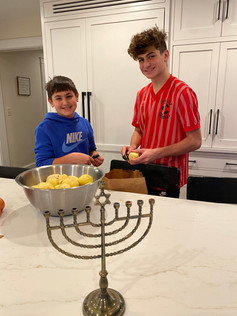Latkes from the heart, with a little history.
- Michelle Iannelli-Rubin
- Dec 15, 2020
- 3 min read
Latkes are potato pancakes made with shredded potatoes, flour, eggs and oil, and served on Hanukkah (The Festival of Lights) typically with applesauce and/or sour cream. They are crispy treats that I incorporated into our holiday tradition the first year we were married embracing my husband’s Ashkenazi roots.
From peeling to shredding then mixing and frying, latkes are a great way to get the whole family in the kitchen to make these a success!
Did you know that in modern day, latkes are fried in oil to symbolize the miracle of Hanukkah, which involved the oil of the Temple menorah; oil that should have lasted only 1 night, but lasted 8 nights. Hanukkah commemorates the rededication of the Temple in 165 BC by the Maccabees after its desecration by the Syrians.

Hanukkah is not about the potato or the latke, but about the oil and the miracle of the oil lasting 8 nights.
Similar to many other faiths, people of Jewish faith eat foods that reflect the significance of the holiday, for example matzah on Passover, apples dipped in honey on Rosh Hashanah, and oily foods on Hanukkah. There is significance attached to these foods in the Jewish faith. And did you know that in addition to fried foods, dairy foods are also associated with Hanukkah? I'm not kidding. Dating back to the Middle Ages, the Book of Judith played an important role in the Hanukkah tale.
In the Book of Judith, a Jewish widow, Judith, uses her beauty and charm to destroy and Assyrian general and save Israel from oppression. She is a heroine that is portrayed as using wine and cheese to distract her enemy before cutting off his head. And though the Book of Judith is not considered part of the official Jewish religious parable, the association to the real military events leading up to the Jewish holiday of Hanukkah became very strong in the Middle Ages.
With continued fascination of the historical connection to foods and the traditions, I dove in a little more and dug deeper. I learned that latkes actually originated in Old Italian Jewish customs dating back to the early 14th century with, of all things...ricotta pancakes! What? Ricotta? Can you believe it? A rabbi in Italy, Rabbi Kalonymus ben Kalonymus (c. 1286-1328) was the first Rabbi to make the connection between Hanukkah and pancakes. According to The Encyclopedia of Jewish Food by Gil Marks, the Rabbi “included pancakes in a list of dishes to serve at an idealized Purim feast, as well as a poem about Hanukkah. After the Spanish expelled the Jews from Sicily in 1492, the exiles introduced their ricotta cheese pancakes, which were called cassola in Rome, to the Jews of northern Italy. Consequently, cheese pancakes, because they combined the two traditional types of foods–fried and dairy–became a natural Hanukkah dish.”

Our American known potato latkes are a more recent Ashkenazi invention that gained popularity in Eastern Europe during the mid 1800’s. After a series of crop failures in Poland and the Ukraine, mass planting of potatoes ensued. Potatoes were easy and cheap to grow and were often consumed boiled or mashed. The Ashkenazis shredded them and fried them in schmaltz (poultry fat (aka liquid gold) elevating the boring staple into magnificent holiday treats that we continue to enjoy today.
Absolutely fascinating.
Ingredients (Makes approximately 30 latkes.)
4 Russett Potoates, peeled & shredded
6 Yukon Potoates, peeled & shredded
2 medium onions, peeled & shredded
3 TBS Matzo Meal (or flour)
1 tsp kosher salt
6 TBS Vegetable oil
Instructions
In medium bowl, mix potatoes & onions. Add in eggs, matzo and salt. Mix well.
Feel consistency of the mixture. It should hold together without being sticky. If it sticks to your hand, add more matzo meal.
In large skillet over MEDIUM heat, warm oil or butter or crisco. Be sure it covers 1/4 inch of skillet.
Drop a heaping tablespoon of mixture into oil. Flatten with spatula. Then flip after a few minutes. Both sides should be golden.
Remove from skillet and place on paper towel.
Serve with applesauce or sour cream.






Comments